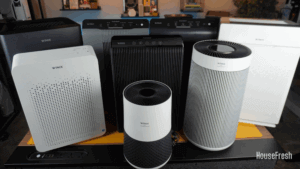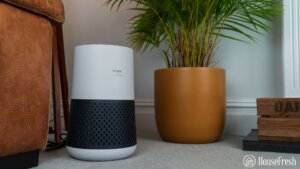After having tested multiple Winix air purifiers, I have grown to become a fan of their brand.
In fact, their trusted and affordable Winix 5500-2 is one of my top recommendations for most people. So you can imagine my excitement with the release of the new Winix line in 2023.
The Winix T810 was first announced in September 2023 as a “cutting-edge” air purifier with “unparalleled 360° air care capability.” These big promises were paired with photos of a sophisticated, “Instagrammable” design that we’ve never seen from Winix.
In this review, I will compare the T810 to the more than 100 air purifiers we have tested at HouseFresh since 2020.
My observations are based on our first-hand data on air cleaning performance, sound generation, energy efficiency, real-life user experience and long-term running costs. You can read more about how we test air purifiers here.
By the way, I bought our T810 for $421.66 on Amazon.com, including the shipping and import fees needed to get it sent to us here in the UK. If you are buying it from the U.S. you will only need to pay $215.
The lowdown on the Winix T810

To put it into perspective, the T810 offers better particle removal performance than what you will get from the popular Coway Airmega AP-1512hh, which has a bigger footprint and costs around the same.”
If you don’t want to read my full review of the Winix T810, here are the three things I like about it, and the three things I don’t:
What we really like
What we think could be better
| HouseFresh rating: | ◼️◼️◼️◼️◼️◼️◼️◻️◻️◻️ 7/10 |
| Time to reach PM1 zero (running at top speed in our 728 cubic feet test room): | – 26 minutes (top speed) – 46 minutes (sub-45 dB speed) |
| Air filtration technology: | True HEPA particle filter with carbon and pre-filter mesh |
| Ionization technology: | PlasmaWave bipolar ionization that can be disabled |
| Recommended room size (5 air changes per hour): | 343 sq. ft. |
| Clean air delivery rate (CADR): | – HouseFresh PM1: 229 cfm – AHAM PM2.5: 267 cfm (dust) |
| Dimensions (in inches / in cm): | 11.3 x 11.3 x 20.4 in (28.7 x 28.7 x 51.8 cm) |
| Weight (in pounds / in kg): | 10.4 lbs (4.7 kg) |
| Filter life: | 12 months |
| Noise level in decibels (measured from 3 ft. away with a sound level meter): | – Sleep mode: 35.1 dBA – Speed 1: 37.4 dBA – Speed 2: 44.8 dBA – Speed 3: 50.3 dBA – Speed 4: 62.5 dBA (top speed) |
| Electricity consumption in watts (recorded with an electricity usage monitor): | – Standby: 0.52 watts – Sleep more: 2.2 watts – Speed 1: 4.40 watts (4.72 w/PlasmaWave) – Speed 2: 8.23 watts (8.47 w/PlasmaWave) – Speed 3: 12.30 watts (13.42 w/PlasmaWave) – Speed 4: 41.92 watts (42.59 w/PlasmaWave) |
| Estimated running cost (electricity consumption + official filter replacement): | – Energy consumption: $47.31 per year – Filter replacement: $79.99 per year |
| Manufacturer’s warranty: | 2 years |
| Country of manufacture: | Thailand |
The best T810 feature: A design that will make you look twice
The Winix T810 won’t look out of place in the most stylish of spaces.

I know looks have nothing to do with air cleaning performance, but it’s hard not to comment on how beautiful the design of the T810 — especially compared to other Winix air purifiers we have tested.
The Winix T810 is easy on the eye thanks to its sleek medium-sized cylindrical design with vertical lines topped by a high-end touchscreen control panel.
If you asked me to choose the best looking air purifier out of the 104 devices I’ve got now in my home, the T810 would be my pick.
A modern and sophisticated device, packed with smart features
The T810 is one of the few air purifiers from Winix with smartphone connectivity.
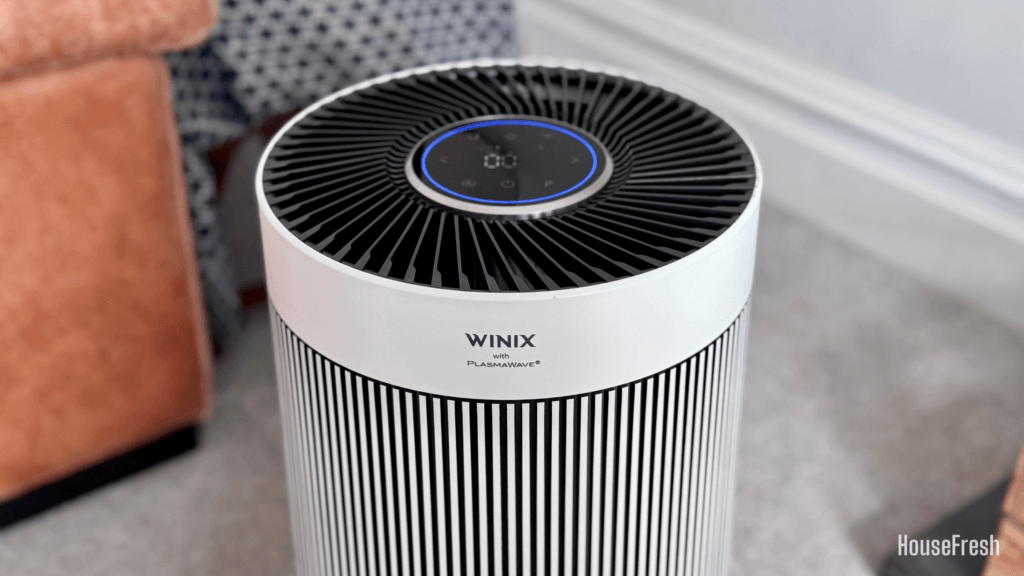
Normally, my wife and I disagree on what we like and dislike about the design of air purifiers, but for once, we are both in agreement that the T810 is a seriously good-looking device.
While design aesthetics shouldn’t be your primary concern when shopping for an air purifier, I understand it’s an important thing to consider because you will need to have the device on show all the time.
If having a better-looking design means more people are more likely to use air purifiers, then I am all for it.
The big difference over other popular Winix devices is the use of a cylindrical design vs the rectangular box we see with the 5500-2, C545, Zero Pro, 5510, Zero S… etc.
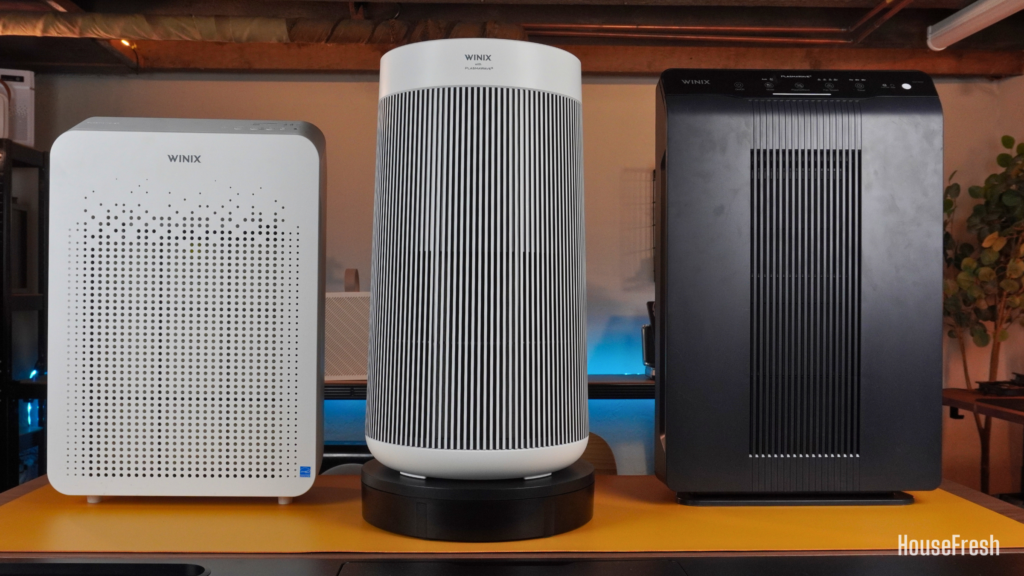
However, there are some downsides to the T810’s cylindrical design.
The 360-degree filter combines all filters into one, so you will have to throw away the entire filter once the carbon layer is full—even if the HEPA filter is perfectly fine.
You have to remove the full filter to vacuum and clean the pre-filter cover. The process is more cumbersome compared to devices with washable removable pre-filters.
That said, the big benefit to the cylindrical design is that the T810 is less bulky and takes up less floor space than other medium-sized air purifiers with similar levels of performance.
You can see in the photo below how the T810 compares to two of our most recommended air purifiers since 2023: the 5500-2 also from Winix (right) and the Levoit Vital 200S (left):
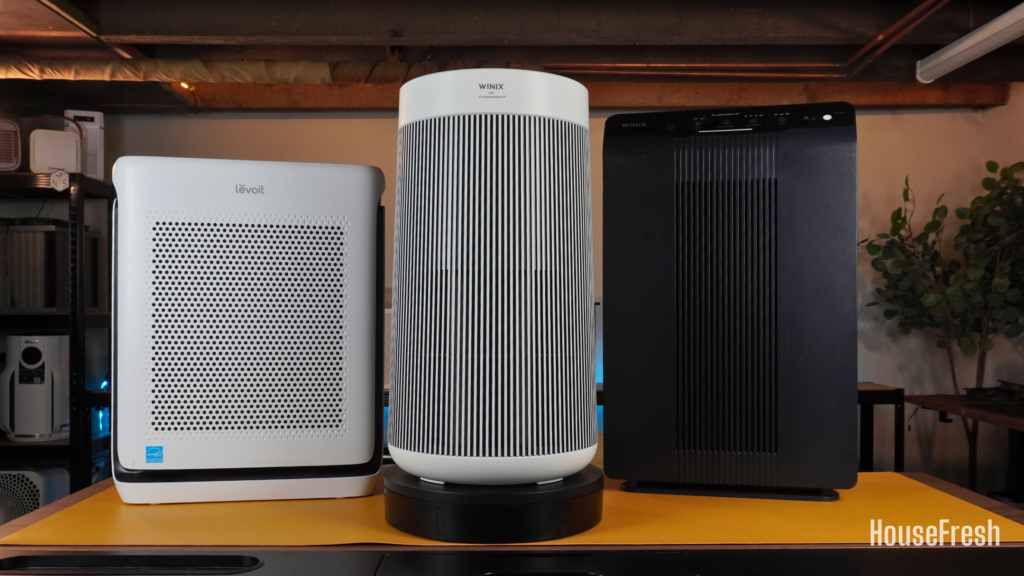
Rather than pulling air from just the front, the T810 pulls air in from all sides of the device, which means you have higher CADR without the usual large size.
Compared to other cylindrical air purifiers such as the Levoit Core series, I much prefer the design choices that Winix has made.
The vertical lines make the T810 feel much more stylish and sophisticated than the usual all-white cylinder shape used by many other air purifier manufacturers.
We chose to go with the Silver design, but you can also choose Blue stripes instead if you go for the T830:
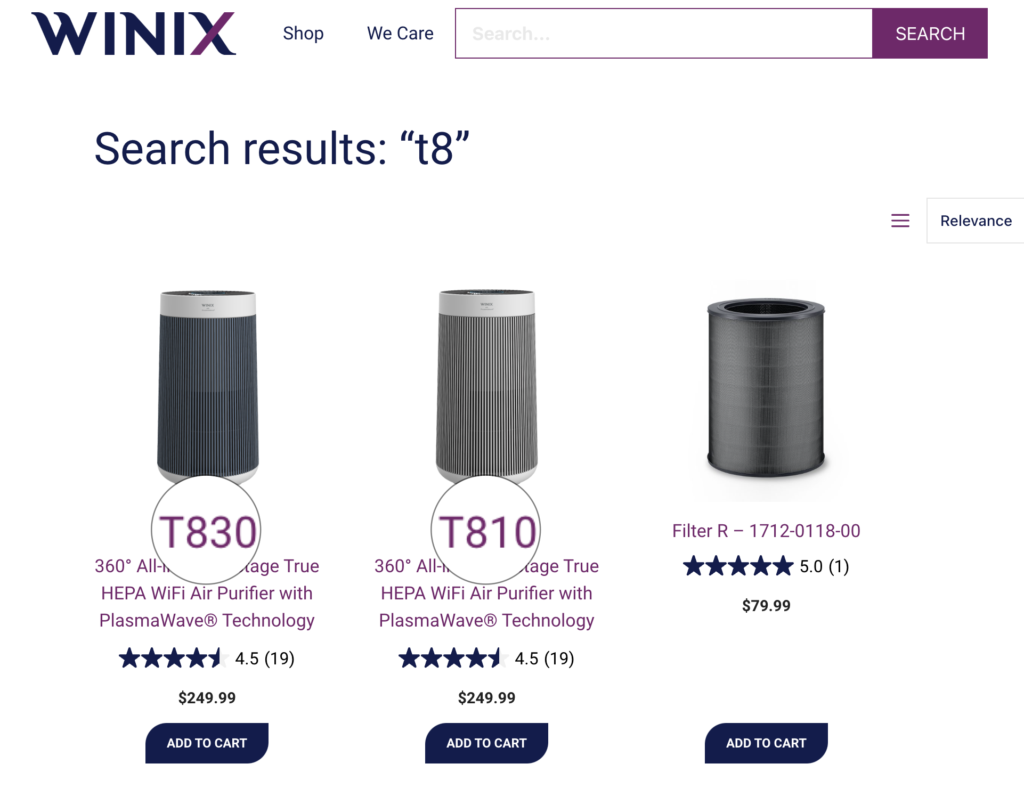
The one thing I dislike about some cylindrical air purifiers is having to access the filter through the bottom of the device. Sadly, this is what Winix decided to do with the T810.
So to access the filter of your T810, you will have to tip the device upside down and turn the handle counter-clockwise to release the cover:
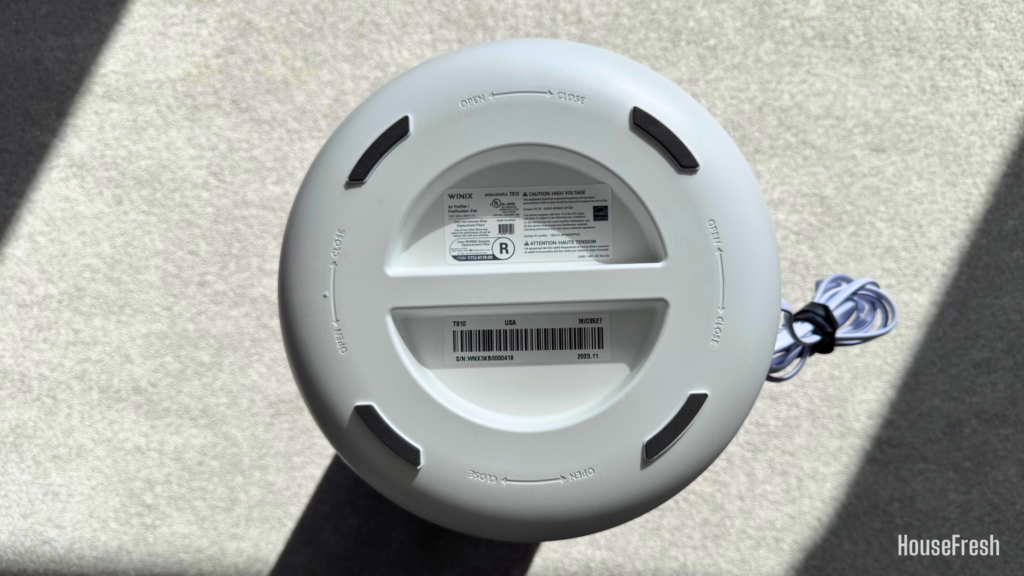
Something my wife reported experiencing a few times, which is a common issue with this type of cover: if you slide the air purifier on the ground from one side to another for some reason (e.g. you’re sweeping the floor), then you might end up unintentionally opening the cover.
Moving on from the design aesthetic, one of the big differences between the T810 and most other Winix air purifiers is the inclusion of an onboard screen and app support.
Not only that.
Like the Winix ZERO Pro, the T810 also comes with two sensors: one for particles and one for gases. This makes the T810 more responsive to air quality changes.
Plus, people often forget to clean the particle sensor and this can negatively affect the reliability of the auto-mode. The addition of the gas sensor is a welcomed inclusion for those cases.
The screen takes a few moments to kick in, but once it does, it shows the level of PM2.5 detected on screen.
You also get an LED light that adjusts its color based on the level of air quality, moving through red (poor) to amber (fair) to green (average) to blue (good).
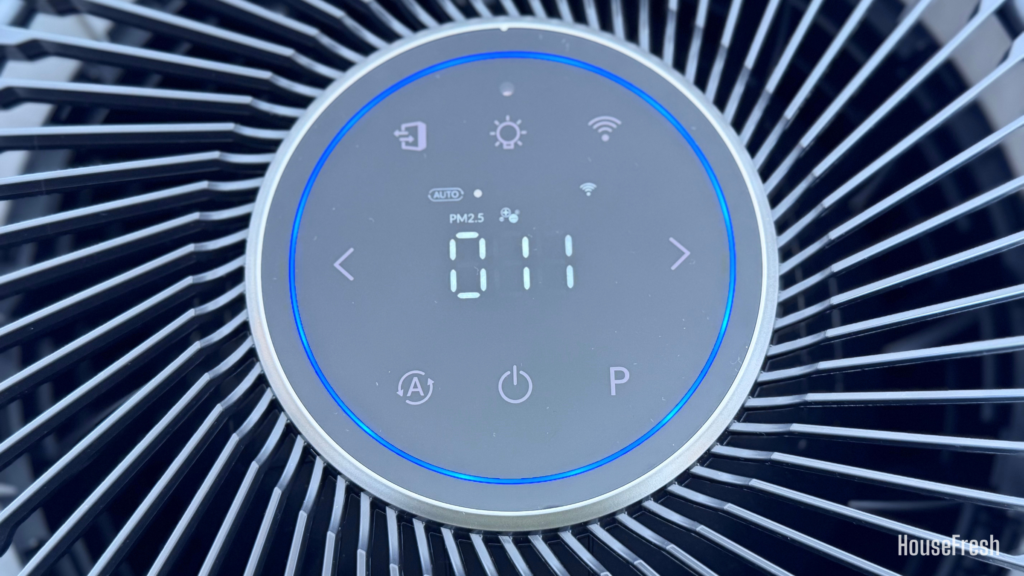
Another innovation from Winix is the inclusion of app connectivity.
The T810 can be paired to the Winix Smart app, which I found easy to install and navigate. The app has a clean UX, without the product ads or content marketing we see with other manufacturer apps such as Levoit.
I tested the Apple app, which has better ratings (4.6 stars) than the Android app (3.3 stars), so perhaps I am one of the lucky ones but I didn’t encounter any issues and I am happy with the app’s functionality. The scheduling function is easy to use, and every other feature can be also controlled from the touchscreen on top of the device and the remote control.
Something I really liked about the app is having the ability to store historical air quality data from the device, but I am a data nerd so it might not be something you’ll care about. I’m also glad Winix didn’t move all the features to the app (as we see with Xioami) because not everyone wants another app.
An all-in-one 360°cylindrical True HEPA filter with an activated carbon coating
It offers good particle filtration but doesn’t come with enough carbon to be effective against serious VOCs or strong smells like cigarette smoke.

Overall, the filter you’ll get with the Winix T810 is very similar to other cylindrical filters we see with many other brands:

But this all-in-one bonded filter is very different from what we expected from Winix.
You see, most Winix air purifiers come with separate filters for carbon and particles. These non-bonded filters from Winix usually come with a removable (and often washable) pre-filter, which makes it easier to quickly clean the pre-filter to help extend the life of the HEPA filter.
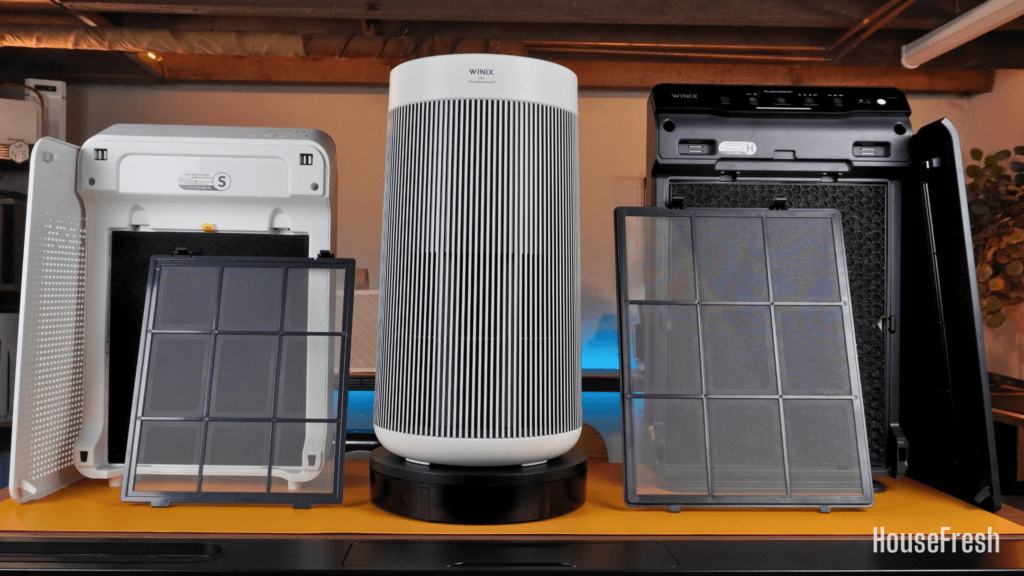
However, the T810 comes with an all-in-one cylindrical filter that includes a pre-filter mesh, a carbon coated layer and a True HEPA filter.
As is the case with every other Winix device, the particle filter of the T810 is HEPA-graded, which means it was independently tested and certified by a lab as True HEPA grade.
And the gas filter consists of a carbon coated layer, which is likely not going to be as effective at tackling chemical gasses and odors compared to a filter with a good amount of pelleted activated carbon.
The Winix T810 cleared our test room in 26 minutes
It matches the performance of the Coway Airmega AP-1512hh, but it was slower than the Levoit Core 400S.

First, we tested the particle removal speed of the Winix T810 running at top speed with PlasmaWave enabled.
According to our PurpleAir Zen sensor, the T810 needed 26 minutes to achieve PM1 zero in our 728 cubic ft. test room:
We can compare this to other similarly-priced devices running at their top speed:

Considering AHAM’s high CADR ratings for this device (267 cfm for dust), I was surprised that it wasn’t quicker than the Winix 5500-2 and Vital 200S.
It’s also fair to say that while the list price ($250) is similar to that of other devices, many (like the Winix 5500-2) are often sold for much less so you are likely to get better value from this older Winix device.
But, these are the results with PlasmaWave enabled, which is not something everyone will want to have as many people avoid ionizers. That is why we disabled PlasmaWave and re-tested the air cleaning performance of this device.
Without using Plasmawave, the T810 needed 27 minutes to achieve PM1 zero – that is just one additional minute from our previous test. This is how this result compares to other air purifiers with and without their ionizers enabled:
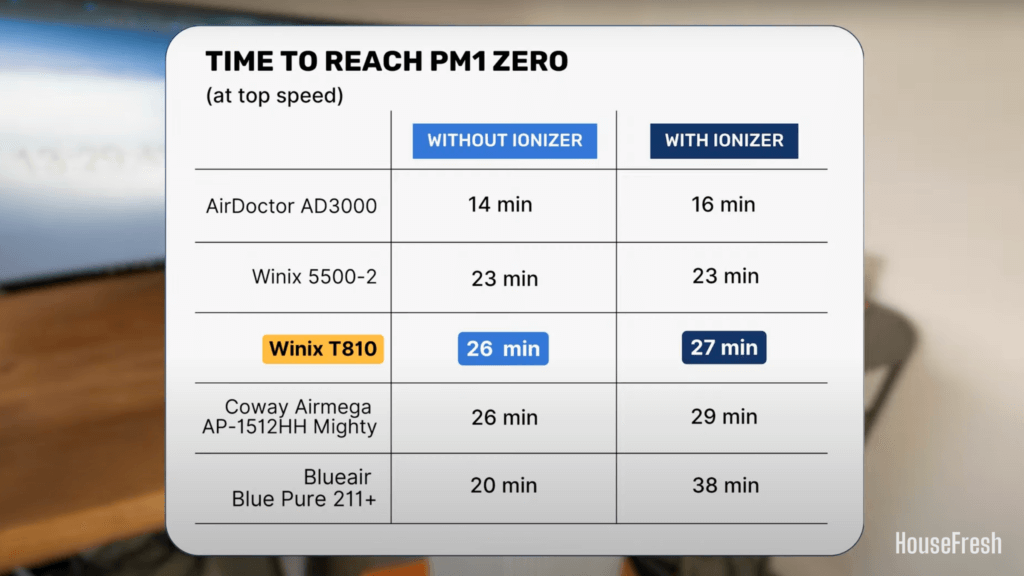
Our data shows that the T810’s PlasmaWave has a fairly low effect on overall air cleaning performance here―especially when compared with what we saw with the Blueair 211+ or the Coway AP-1512HH. So, I see no downside to running your T810 without PlasmaWave enabled if you want to avoid bipolar ionization.
It is louder at top speed than other mid-sized air purifiers we recommend
In our testing, the sound levels of the Winix T810 ranged from 35.1 dBA to 62.5 dBA.
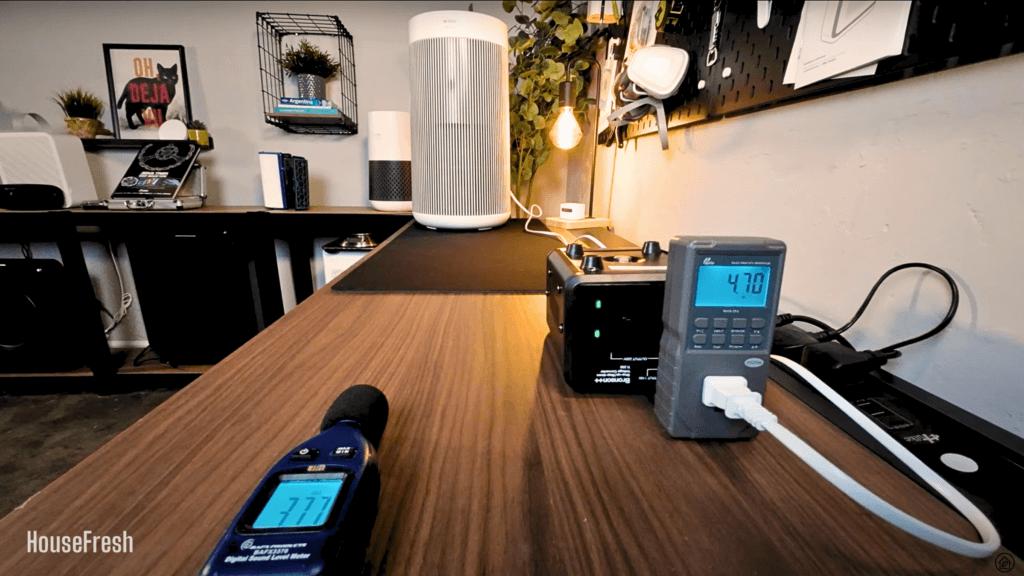
If an air purifier is too loud, you will find yourself turning it off eventually. That is why we always measure how much sound they generate from 3 ft. away with a sound monitor.
These are the results for the T810:
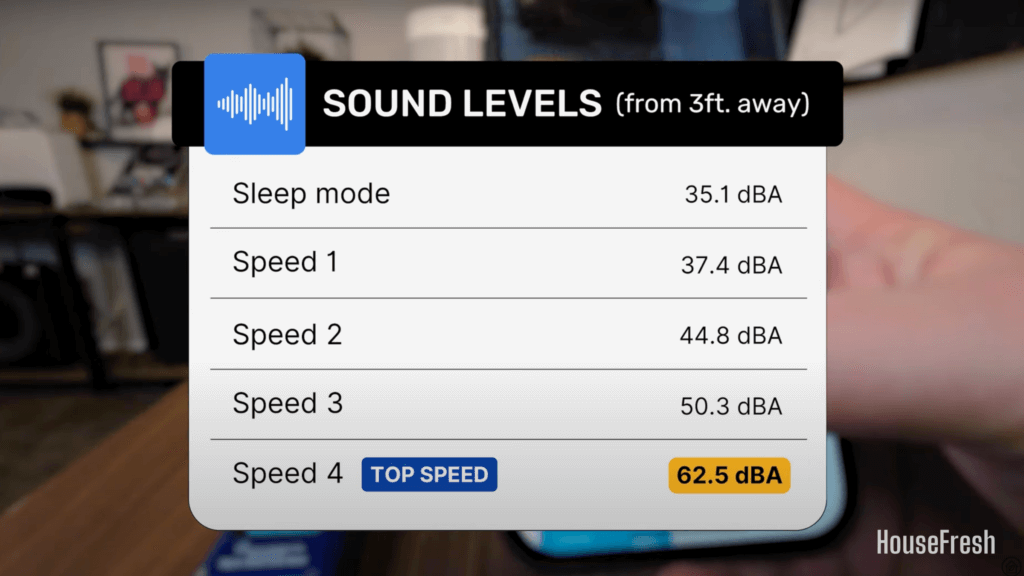
Be aware our background noise is 35 dBA, so the T810 running at speed one (1) is likely to generate less sound if you could measure it in a silent room.
As you can see from the table below, the T810 does run louder than many of the other similar-performing air purifiers we have benchmarked:

Next, we re-tested the particle removal performance of the T810 when running at its lower fan speeds.
Running at speed two (2), it generates 44.8 dBA, which is just below the 45 dBA limit that CleanAirStars recommends for noisy classrooms or offices. At this speed, the T810 managed to reach PM1 zero in 46 minutes.
When running at sub 45 dBA, the T810 performs similarly to other popular devices, such as the Levoit Vital 200S and Winix 5500-2 although you do get better performance at the same sound level with the Levoit Core 400S:
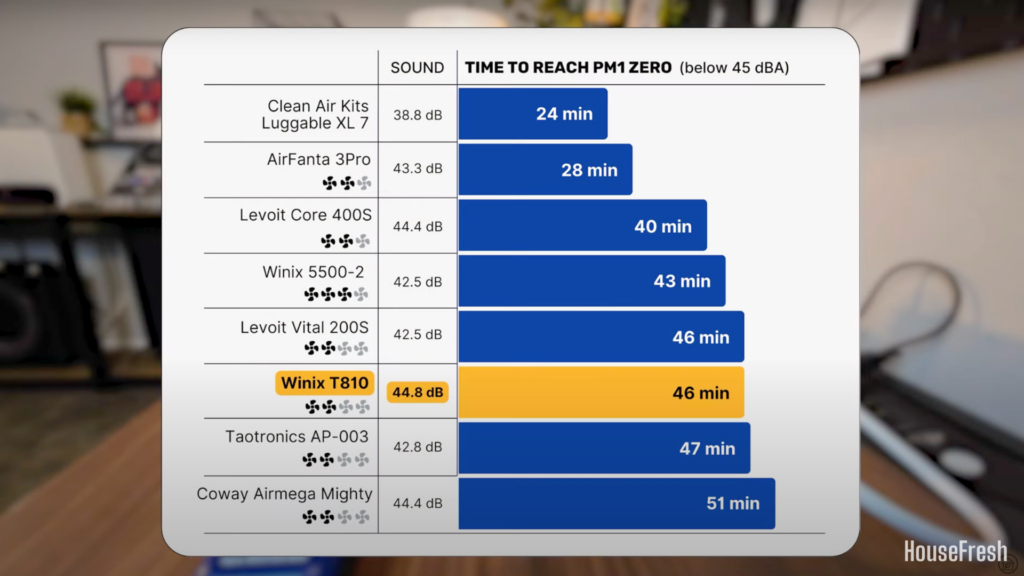
As I expected, our data shows that the T810 is completely outmatched by PC fan-powered devices like the CleanAirKits Luggable XL-7 and the AirFanta 3Pro. But this makes sense as PC fans are whisper quiet.
The cost to run a Winix T810: $126.64 per year
We look at how much the T810 will cost you in the long term, including your energy bill and filter replacement costs.
1. Electricity costs = $46.65 per year
As always, we used our energy meter to record how much energy the T810 uses when running at each fan speed and also while on standby.
I also made sure to measure how much power was used once I disabled PlasmaWave:
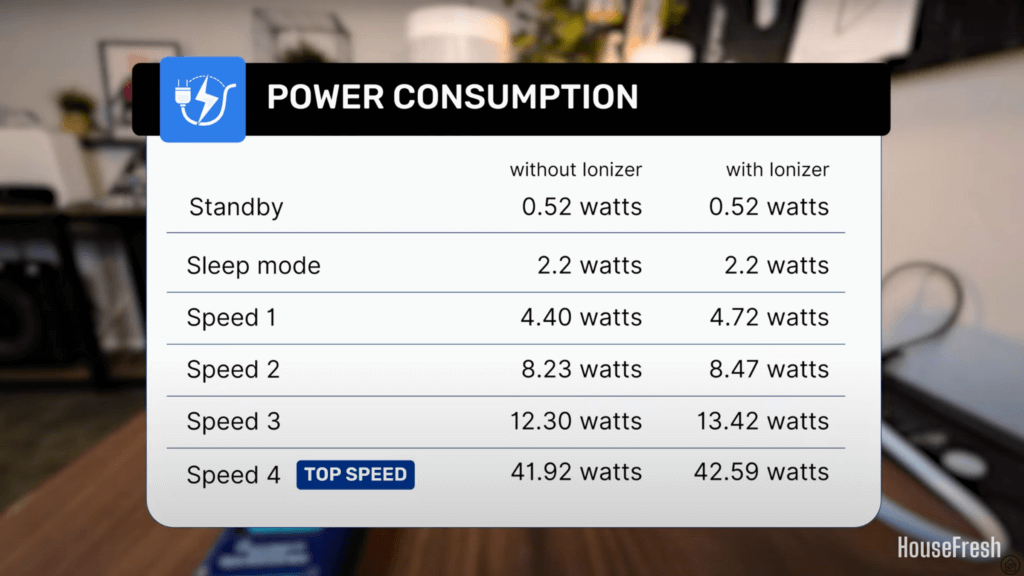
If you were to leave your Winix T810 running 24/7 at its top speed with PlasmaWave enabled, it would add $46.65 to your energy bill within a year.
With this calculation in mind, we can compare the annual energy costs you can expect from the T810 to other devices we have tested.
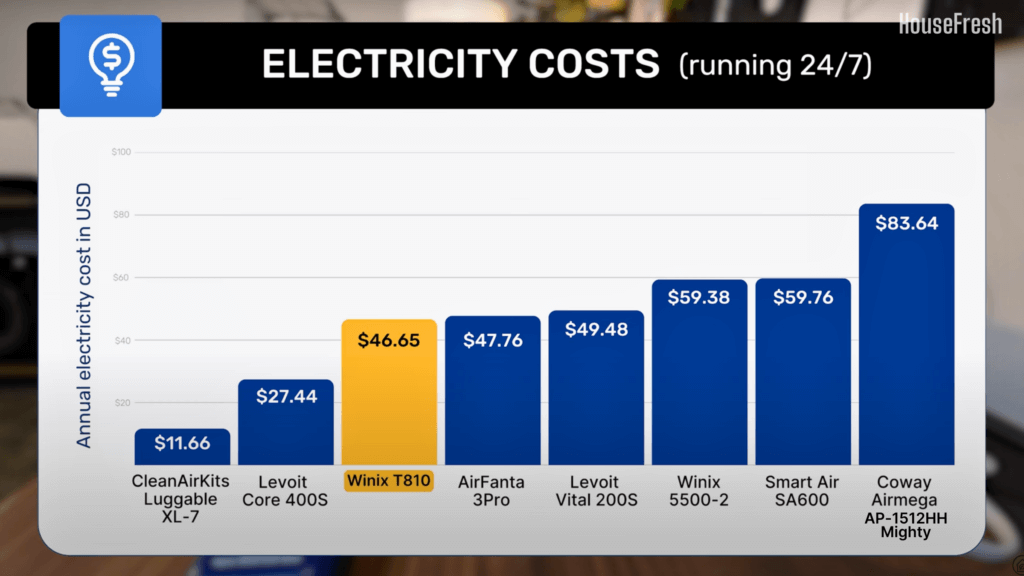
At this point, we can see the improvements WInix has made as the T810 is more energy-efficient than the popular 5500-2. That said, if you’re looking for a cheaper alternative to run, you might want to consider the Levoit Core 400S or the CleanAirKits Luggable XL-7.
2. Filter costs = $79.99 per year
It’s not just energy costs that add to the running cost of an air purifier, you will also need to replace the filters eventually.
Winix says that you need to replace the filters for the T810 every 12 months and their OEM Filter R filter costs $79.99.
- Compatible with Winix air cleaner model T810
- Fine Mesh Pre-Filter: The first line of defense against the largest airborne particles found indoors
- True HEPA Filter: Captures 99.99%* of airborne allergens including pollen, dust, pet dander, and smoke (particles as small as 0.01 microns in size)
- Activated Carbon Filter: Reduces VOCs and household odors from cooking, pets, and smoke. It is designed to catch airborne particles found indoors
- Genuine Winix one year replacement filter set. For optimal performance, it is recommended to change the All-in-one True HEPA Canister Filter once every 12 months
So you can expect to pay $79.99 each year on filter replacements for the T810.
As you can see from the chart below, the annual running costs of the T810 are higher than what you can expect from units like the Levoit Vital 200S or the Coway Airmega Mighty.
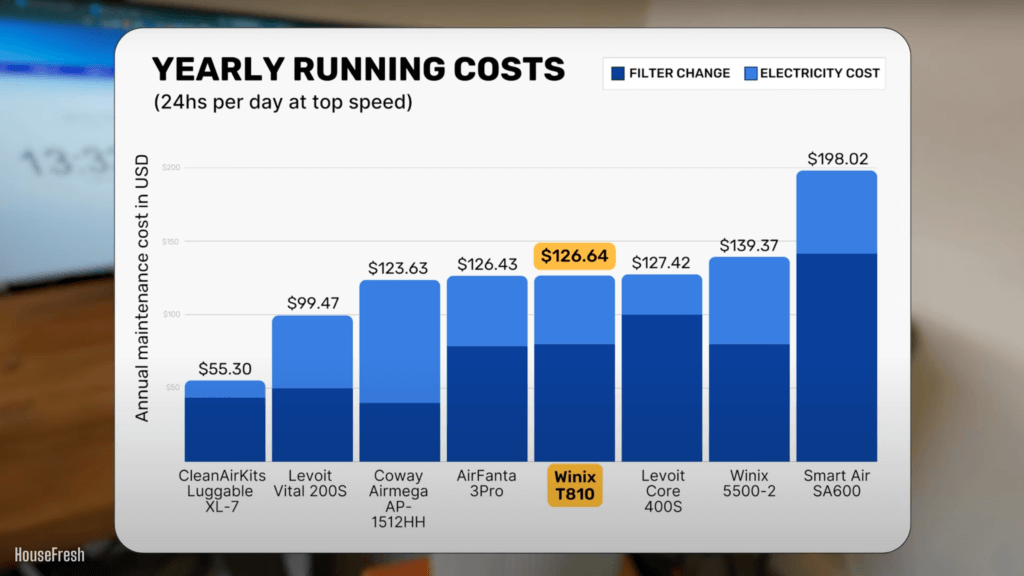
As this air purifier is fairly new, I was happy to see that you can already get generic filters from PUREBURG for $29.22 for one filter.
Now, I wasn’t able to buy a PUREBURG filter from the UK to test it with the T810, but based on tests I’ve run with other air purifiers, I have found PUREBURG filters usually offer similar performance to genuine filters.
- H13 3-Stage Filtration True HEPA Filter,1-Pack
- Compatible with Winix T810 T820 T830 Large Room Air Purifier 1712-0118-00 (Filter R)
- H13 HEPA capture up to 99.97% of PM2.5 particles as small as 0.3 microns. This includes dust, pet dander and other minute particles ,Activated Carbon reduce Chemicals VOCs, tobacco smoke,PM2.5,common household bad smell,Fine Mesh Layer Prevents large particles such as dander,Pet hair
- Please replace regularly to keep your machine fresh and clean. For the best performance, clean the filter once a month with a soft brush gently or with a vacuum cleaner.
- Top Notch Quality Used for Maximum Customer Satisfaction Guaranteed. Every Product made by PUREBURG is Tested through Rigid Examinations and QC Procedures.
However, performance will vary depending on the amount of carbon included in the filter and the grade of HEPA you get with the particle filter.
I will be running some experiments with my Winix T810 for our Patreon supporters, and I’ll make sure to test its performance using generic filters from PUREBURG as soon as I can buy them here in the UK.
Bottom line: Should you get the Winix T810?
Well, for most people, the older Winix 5500-2 will be a better choice.
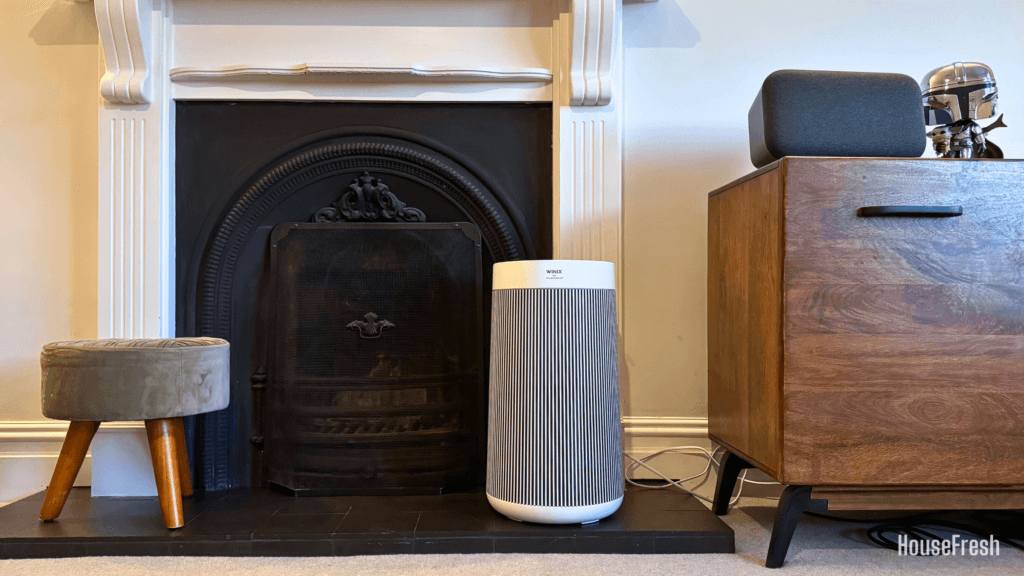
If what you want is an air purifier with above-average air cleaning performance, then the T810 isn’t it.
You will get a better air purifier in the older Winix 5500-2 as it provides better air-cleaning performance, comes with pelleted activated carbon (which will be better for odors in the long term) and also has a removable pre-filter that you will find easier to clean regularly.
However, the 5500-2 is a big black box without app support. So, considering design and features, I’d say the main competitor to the T810 is the Levoit Core 400S, which has a similar design, comes with app support and sells for $219.99 (although you’ll usually find it cheaper than that).
Now, does the Core 400S look as sleek as the Winix T810? Well… no.
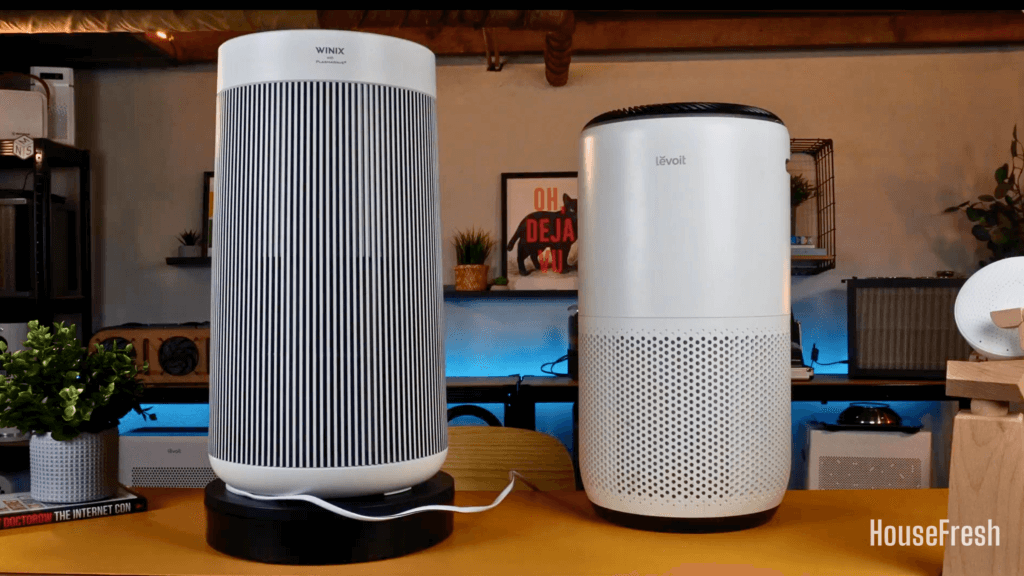
If you are looking for a stylish air purifier that won’t look out of place in even the most well decorated spaces, then the Winix T810 is the best-looking air purifier you can buy for less than $220. I even prefer it to the also new Winix 5510, which is louder and bulkier compared to the T810.
If you end up deciding that the Winix T810 is the right air purifier for you and want to support the work we do here at HouseFresh, please make sure to use this link to make your purchase — you won’t pay anything extra but we will get a 3% commission from Amazon.
Do you have any questions about the Winix T810? Have you bought the T810 and are using it at home? Please drop your question or share your experience in the comments below, and I’ll get back to you as soon as I can.
SOURCES
We calculated energy consumption costs with the help of the Department of Energy’s appliance energy calculator. We calculated yearly costs associated with running the Winix T810 for 24hs a day for 365 days. We ran this calculation utilizing the U.S. average utility rate of $0.1268/kWh as of March 17th, 2025.


